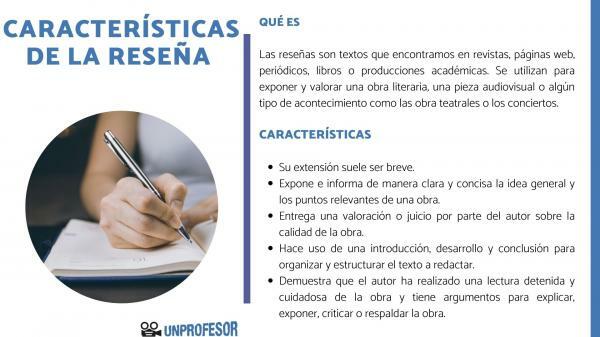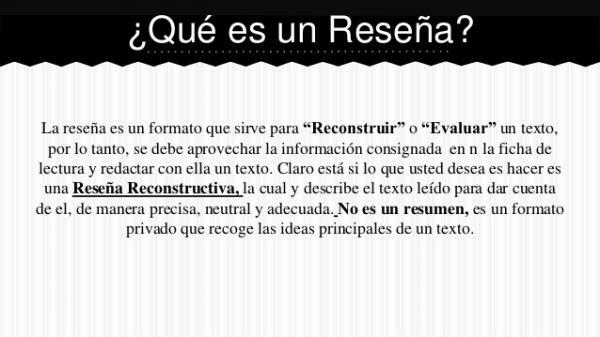5 FEATURES of the most important REVIEW

When we need to examine a book, a movie, a record or even an event, we find certain types of texts that help us to do so. With the summaries we can synthesize the general idea of said material, with the essay we can take a critical stance on it. In the case of the review, it allows us to both synthesize and analyze the work. In this lesson from a TEACHER we will review the review features and we will show the specific case of the literary reviews.
Index
- What is a review and what is it for?
- Structure of a review and its parts
- 5 characteristics of a review
- Characteristics of literary reviews
What is a review and what is it for?
Reviews are texts that we find in magazines, web pages, newspapers, books or academic productions. This type of writing are used to expose and value a literary work, an audiovisual piece or some type of event such as theatrical works or concerts. You could say that the review is the midpoint between the abstract and the essay.
If we are faced with the task of summarizing the famous book of Ernesto Sábato "The Tunnel", we will surely concentrate on making a general tour of the plot and the events of the novel. We will not give an evaluation or an in-depth analysis. In the case of doing an essay, we will have to take a position regarding the book (for example, defend that Sábato exposes a existentialist or pessimistic position through the protagonist of his novel) and argue such an interpretation throughout our written. In the case of the review we must find the balance between these two extremes.
As Sergio Navarrete points out in his guide for the preparation of reviews, we must inform or expose "The main aspects of reading (circumstances, structure, thesis, main ideas) ”and, additionally, we must add“ a component evaluative where it is argued whether or not the text is relevant according to the purpose settled down".

Image: Slideshare
Structure of a review and its parts.
In this sense, the review is not limited to a simple synopsis, but neither does it go to the extreme of taking a critical stance in its entirety. If not, he finds the balance between these two approximations. Therefore, to meet its objective, it has aconcrete structure which is divided into three parts fundamental:
- Start: In this section we must present the work to be reviewed. The name, the author, the year of publication and other necessary references. In the same way, a general overview or overview is made of what will be covered in the text.
- Developing: In this section we make a synopsis and highlight the most important elements of the reviewed work. To give a bridge to the conclusion, at the end of this point we can introduce the assessment or judgment on the strengths, weaknesses, criticisms, advantages and disadvantages of the work.
- Conclution: Finally, the author must make a synthesis and recapitulate the path that she has traveled during her writing with one or a couple of closing paragraphs.
5 characteristics of a review
Since we have reviewed what it is and what it is for, now we can highlight the 5 characteristics of a review most outstanding:
- Its extension is usually brief.
- Exposes and informs in a way clear and concise the general idea and the relevant points of a work.
- Hand over a assessment or judgment by the author on the quality of the work.
- Makes use of a introduction, development and conclusion to organize and structure the text to be written.
- It shows that the author has made a reading stopped and careful of the work and has arguments to explain, expose, criticize or support the work.

Characteristics of literary reviews.
Reviews can be of different types. Particularly, the literary review is responsible for analyzing and presenting stories, poems or novels. As we have already seen, its purpose is not only to give a general overview of the work, but also to know the author's assessment. For this reason, they play a very important role in promoting a book, since they are those "thermometers" that tell the public: "this book is about this and it is worth it for these reasons."
However, reviews are not only useful before reading a book, many people read literary reviews in order to know other points of view about the interpretation of a work. In this way, although they do not provide in-depth arguments such as essays, they do allow us to know a plurality of positions and voices regarding how the launch of a literary product is received. Thus, there are several points that literary reviews must meet:
- Brief references to who is the author of the work to be reviewed.
- Retrieve the title of the work and other publication data such as the year of publication and printing, the genre, the extension and the type of work.
- Reconstruct the main plot or plot.
- Examine the relevant characters, spaces and situations in the work.
- Give a critical, judicious and well-argued assessment that allows us to take a position on the work as a whole.
If you want to read more articles similar to Review Features, we recommend that you enter our category of Writing.
Bibliography
- Navarrete, S. (s.f.). Guide to writing a review. Colombia: University of the Andes.
- Noguera, R. (2014). The review. Colombia: Sergio Arboleda University.



